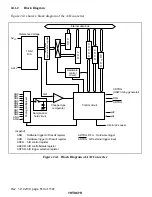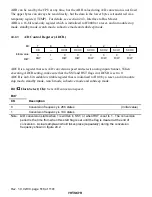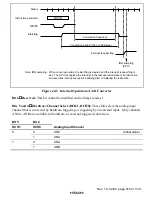
Rev. 1.0, 02/00, page 527 of 1141
24.4
Operation
The A/D converter operates by successive approximations with 10-bit resolution.
24.4.1
Software-Triggered A/D Conversion
A/D conversion starts when software sets the software A/D start flag (SST bit) to 1. The SST bit
remains set to 1 during A/D conversion, and is automatically cleared to 0 when conversion ends.
Conversion can be software-triggered on any of the 12 channels provided by analog input pins
AN0 to ANB. Bits SCH3 to SCH0 in ADCR select the analog input pin used for software-
triggered A/D conversion. Pins AN8 to ANB are also available for hardware- or external-
triggered conversion.
When conversion ends, SEND flag in ADCSR bit is set to 1. If ADIE bit in ADCSR is also set to
1, an A/D conversion end interrupt occurs.
If the conversion time or input channel selection in ADCR needs to be changed during A/D
conversion, to avoid malfunctions, first clear the SST bit to 0 to halt A/D conversion.
If software writes 1 in the SST bit to start software-triggered conversion while hardware- or
external-triggered conversion is in progress, the hardware- or external-triggered conversion has
priority and the software-triggered conversion is not executed. At this time, BUSY flag in
ADCSR is set to 1. The BUSY flag is cleared to 0 when the hardware-triggered A/D result
register (AHR) is read. If conversion is triggered by hardware while software-triggered
conversion is in progress, the software-triggered conversion is immediately canceled and the SST
flag is cleared to 0, and SCNL flag in ADCSR is set to 1. The SCNL flag is cleared when
software writes 1 in the SST bit to start conversion after the hardware-triggered conversion ends.
















































